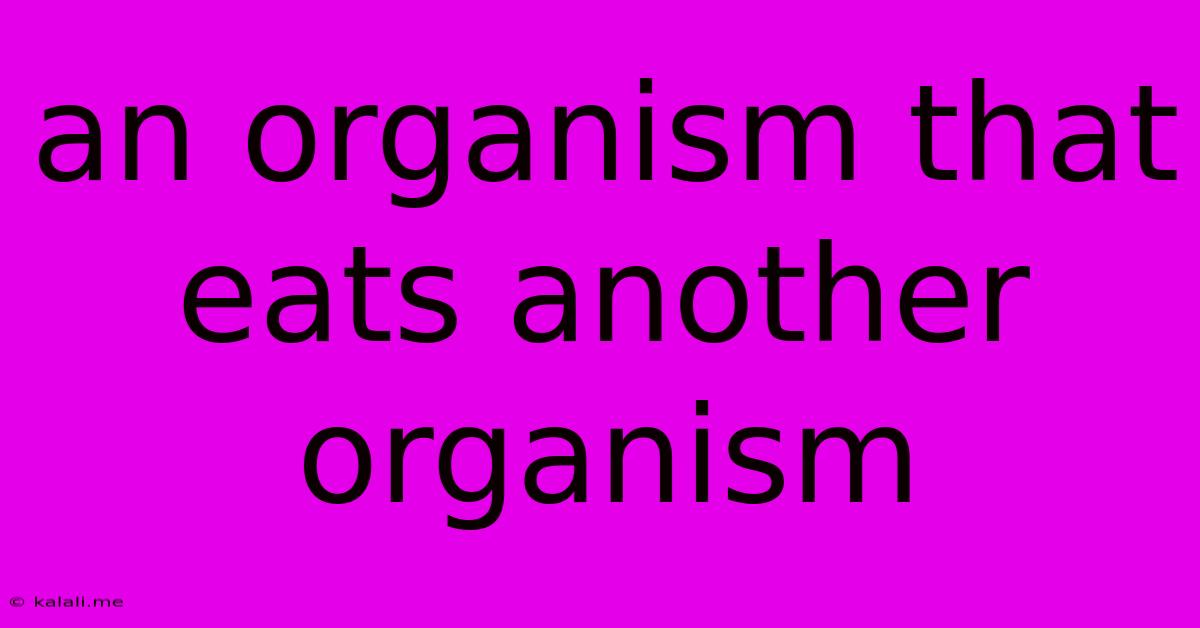An Organism That Eats Another Organism
Kalali
Jun 15, 2025 · 3 min read

Table of Contents
Predation: When One Organism Eats Another
This article explores the fascinating and vital ecological interaction known as predation – where one organism, the predator, kills and consumes another organism, the prey. This seemingly simple interaction is actually a complex web of evolutionary adaptations, population dynamics, and ecosystem stability. Understanding predation is crucial for comprehending the intricate balance of life on Earth.
Predation is a cornerstone of many food webs, driving the flow of energy and nutrients through ecosystems. It's a fundamental process shaping the distribution and abundance of species, influencing biodiversity, and even contributing to the evolution of new traits in both predators and prey. From the microscopic world of single-celled organisms to the vast landscapes inhabited by apex predators, predation plays a significant role.
Types of Predation
While the core concept remains the same – one organism consuming another – there are different forms of predation, each with its nuances:
-
Carnivory: This involves a predator killing and eating an animal. Examples range from lions hunting zebras to ladybugs consuming aphids. Carnivores are often characterized by sharp teeth, claws, or other adaptations for capturing and killing prey.
-
Herbivory: This is the consumption of plants by animals. While herbivores don't typically kill the plant outright (though they can damage or kill it), the act of consuming plant tissue is considered predation. Deer grazing on grass, caterpillars eating leaves, and rabbits munching on carrots are all examples of herbivory.
-
Parasitism: This is a special type of predation where the predator, the parasite, lives on or in the host organism and consumes its tissues or fluids. Parasites often don't kill their host immediately (though they can weaken it significantly), instead benefiting from a prolonged interaction. Ticks feeding on blood, tapeworms living in the intestines, and fleas on mammals are all examples of parasitic predation.
-
Cannibalism: A less common but significant form of predation, cannibalism involves an organism consuming another of its own species. This behaviour can be driven by resource scarcity, territoriality, or other factors.
Evolutionary Arms Race
The relationship between predator and prey is often described as an "evolutionary arms race." Predators constantly evolve strategies to improve their hunting efficiency – sharper teeth, faster speed, better camouflage – while prey evolve defenses to avoid being eaten. These defenses can include camouflage, mimicry, thorns, toxins, or behavioral adaptations like fleeing or forming herds. This constant interplay drives the evolution of both species, leading to remarkable adaptations.
Impact on Ecosystems
Predation significantly influences ecosystem structure and function. It can regulate prey populations, preventing overgrazing or outbreaks of certain species. By controlling prey numbers, predators indirectly influence the abundance of other organisms within the ecosystem. The removal of a top predator can have cascading effects, leading to trophic cascades and significant changes in ecosystem dynamics. This highlights the importance of maintaining biodiversity and understanding the complex interactions within ecological communities. Studying predator-prey relationships helps us predict and manage ecosystem health and stability.
Conclusion
Predation, in its various forms, is a fundamental process driving ecological interactions and shaping the evolution of life. Understanding the dynamics of predator-prey relationships is critical for conserving biodiversity and managing ecosystems sustainably. From the microscopic to the macroscopic, the act of one organism consuming another is a powerful force shaping our planet's rich tapestry of life.
Latest Posts
Latest Posts
-
Consider The Linear Transformation T From R3 To R2 With
Jun 15, 2025
-
What Does The Following Sign Indicate
Jun 15, 2025
-
According To Dalton Atoms Cannot Be
Jun 15, 2025
-
Asthenosphere Is Part Of Which Layer Of Earth
Jun 15, 2025
-
What Is The Meaning Of Evs
Jun 15, 2025
Related Post
Thank you for visiting our website which covers about An Organism That Eats Another Organism . We hope the information provided has been useful to you. Feel free to contact us if you have any questions or need further assistance. See you next time and don't miss to bookmark.